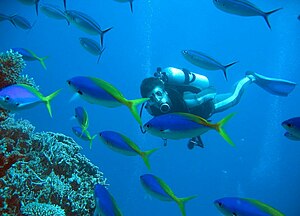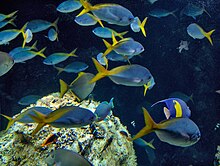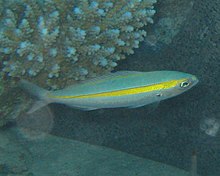Fusiliers (fish)
| Fusiliers | ||||||||||||
|---|---|---|---|---|---|---|---|---|---|---|---|---|

Caesio teres (blue-yellow) and Caesio caerulaurea (monochrome) |
||||||||||||
| Systematics | ||||||||||||
|
||||||||||||
| Scientific name | ||||||||||||
| Caesioninae | ||||||||||||
| Bonaparte , 1832 |
The fusiliers (Caesioninae) are a subfamily of the snapper (Lutjanidae) in the group of perch relatives (Percomorphaceae). They live in huge swarms of sometimes millions of individual animals and often together with different species in the tropical Indo-Pacific in the open water near coral reefs . They received their German name because of the precise, coordinated movements of swarms to the drill of Fusiliers remember.
features
Fusiliers are 10 to 60 centimeters long. Their bodies are spindle-shaped and usually a bit slimmer than that of the snapper . Their color is uniform or has streaks of color. The caudal fin is deeply forked and has no markings or dark tips or dark median stripes in both fin lobes. Their contiguous dorsal fin continuously decreases in height from front to back, is usually put on and is not visible when the fish is swimming. It is supported by 10 to 15 hard and 8 to 22 soft rays. In the anal fin there are three hard and 9 to 13 soft rays. The base of the pectoral fin is usually dark. The number of their vertebrae is 24. Their scales are small comb scales . 45 to 88 scales are counted along the sidelines .
The highly specialized zooplankton eaters have large eyes and a small, overhead mouth that is about 40 to 50 ° to the horizontal. The jaws are covered with small, conical teeth that are distributed very differently over the jaws and the palate. Two types are toothless. The upper jaw of the fusiliers can be extended far (protractile). On their premaxillary (intermaxillary bone) there are one or two finger-shaped appendages, which are only visible when the mouth is pushed forward and are an important taxonomic characteristic for differentiating the different species. The number of Branchiostegal rays is seven. The fusiliers differ from the other snappers by the upper part of their premaxillary, which ossifies separately from the lower part.
Way of life
During the day, the fusiliers are usually active and swim quickly to search for food over coral reefs, on outer reefs and in deep lagoons and often venture very far away from the reef. Fusiliers eat larger zooplankton. If they encounter a high concentration of zooplankton and there are no predatory fish in the vicinity, the shoal will break up into smaller, loose groups to feed. If everyone is full, the food source is exhausted or predatory fish approach, the school forms again. Fusiliers spend the night hidden in the reef. In doing so, they often take on a red night color.
They are frequent visitors to cleaning stations. Since there are always too many of them, a large number of the fish have to wait their turn. The swarm moves on, follow the fish that are not of ecto parasites were cleaned.
Ecological importance
Fusiliers are themselves an important prey for larger predatory fish such as tuna , grouper and larger snapper. They are also fished, consumed, or used as bait in the tuna fishery by humans. In the Maldives , where they are very common, fishermen splash water on the surface of the sea, attracting the zooplankton, which the fusiliers follow. They are then fished from rowboats with rods without bait and barbed hooks.
Reproduction
The reproduction of the fusiliers is still little known. They are likely to reach sexual maturity very early and have high fertility. Their reproductive time is long and concentrated in one or two periods of the year. Some species have been observed spawning at twilight under the full moon, with the fish swimming quickly around each other, rising to the surface of the water and releasing their gametes . This is repeated several times in a row. Other species spawn near the ocean floor. The eggs and larvae are pelagic .
Fusiliers have no external sex differences and, like many marine perch relatives, are proterogynous hermaphrodites that change their sex in the course of their life (first female, then male). The ratio of the sexes is supposedly balanced in a swarm.
Systematics
There are four genera and 23 species .
- Genus Caesio ( Lacepède 1801)
- Yellow- stripe fusilier ( Caesio caerulaurea ) (Lacepède 1801)
- High-backed fusilier ( Caesio cuning ) ( Bloch 1791)
- Sky blue fusilier ( Caesio lunaris ) ( Cuvier 1830)
- Black stripe fusilier ( Caesio striata ) ( Rüppell 1830)
- Red Sea Fusilier ( Caesio suevica ) ( Klunzinger 1884)
- Yellow bridge fusilier ( Caesio teres ) ( Seale 1906)
- Multi-striped fusilier ( Caesio varilineata ) (KE Carpenter 1987)
- Gelbrand Fusilier ( Caesio xanthonota ) ( Bleeker 1853)
- Caesio xanthalytos Holleman, Connell & Carpenter, 2013
- Genus Dipterygonotus (Bleeker 1849)
- Sardine fusilier ( Dipterygonotus balteatus ) ( Valenciennes 1830)
- Genus Gymnocaesio (Bleeker 1876)
- Dwarf fusilier ( Gymnocaesio gymnoptera ) (Bleeker 1856)
- Genus Pterocaesio (Bleeker 1876)
- Pterocaesio capricornis (Smith & Smith 1963)
- Gold streak fusilier ( Pterocaesio chrysozona ) (Cuvier 1830)
- Two- lined fusilier ( Pterocaesio digramma ) (Bleeker 1865)
- Pterocaesio flavifasciata Allen & Erdmann, 2006
- Side stripe fusilier ( Pterocaesio lativittata ) (Carpenter 1987)
- Double- lined fusilier ( Pterocaesio marri ) (Schultz 1953)
- Pterocaesio monikae Allen & Erdmann, 2008
- Pisang fusilier ( Pterocaesio pisang ) (Bleeker 1853)
- Lantern fusilier ( Pterocaesio randalli ) (Carpenter 1987)
- Pterocaesio tessellata (Carpenter 1987)
- Neon fusilier ( Pterocaesio tile ) (Cuvier 1830)
- Three-lined fusilier ( Pterocaesio trilineata ) (Carpenter 1987)
literature
- Joseph S. Nelson : Fishes of the World , John Wiley & Sons, 2006, ISBN 0-471-25031-7 .
- Kurt Fiedler: Textbook of Special Zoology, Volume II, Part 2: Fish , Gustav Fischer Verlag Jena, 1991, ISBN 3-334-00339-6 .
- Hans A. Baensch / Robert A. Patzner: Mergus Sea Water Atlas Volume 7 Perciformes (perch-like) , Mergus-Verlag, Melle, 1998, ISBN 3-88244-107-0 .
- Ewald Lieske / Robert F. Myers: Coral fish of the world . 1994, year publisher, ISBN 3-86132-112-2 .
- Dieter Eichler / Robert F. Myers: Korallenfische Indopazifik , Jahr-Verlag GmbH & Co., 1997, ISBN 3-86132-225-0 .
Individual evidence
- ^ Miller, TL & TH Cribb. 2007. Phylogenetic relationships of some common Indo-Pacific snappers (Perciformes: Lutjanidae) based on mitochondrial DNA sequences, with comments on the taxonomic position of the Caesioninae. Molecular Phylogenetics and Evolution, Volume 44, Issue 1, July 2007, DOI: 10.1016 / j.ympev.2006.10.029
- ↑ Betancur-R, R., E. Wiley, N. Bailly, M. Miya, G. Lecointre & G. Ortí. 2014. Phylogenetic Classification of Bony Fishes --Version 3 ( Memento of the original from August 14, 2015 in the Internet Archive ) Info: The archive link was inserted automatically and has not yet been checked. Please check the original and archive link according to the instructions and then remove this notice.
Web links
- Family Caesionidae - Fusiliers on Fishbase.org (English)




